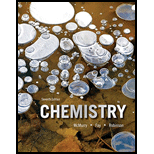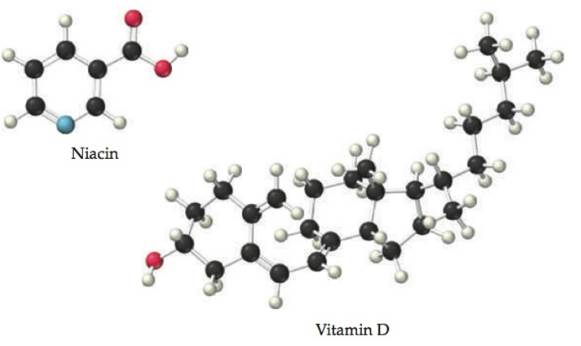
Chemistry
7th Edition
ISBN: 9780321940872
Author: John E. McMurry, Robert C. Fay, Jill Kirsten Robinson
Publisher: PEARSON
expand_more
expand_more
format_list_bulleted
Concept explainers
Textbook Question
Chapter 12, Problem 12.29CP
Many people take vitamin supplements to promote health and the potential for overdose depends on whether a particular vitamin is fat soluble or water soluble. If a vitamin is soluble in nonpolar fatty tissues it will accumulate in the body, whereas water-soluble vitamins are readily excreted. Use the ball-and-stick models of niacin and vitamin D to determine which is more fat soluble.

Expert Solution & Answer
Want to see the full answer?
Check out a sample textbook solution
Students have asked these similar questions
The quantum yield of the photochemical decay of HI is 2. Calculate the number of Einsteins absorbed per mole knowing that the energy absorbed per mole of photons is 490 kJ.
The quantum yield of the photochemical decay of HI is 2. How many moles of HI per kJ of radiant energy can be decayed knowing that the energy absorbed per mole of photons is 490 kJ.
If the energy absorbed per mole of photons is 450 kJ, the number of Einsteins absorbed per 1 mole.
Chapter 12 Solutions
Chemistry
Ch. 12 - Prob. 12.1PCh. 12 - Prob. 12.2ACh. 12 - Prob. 12.3PCh. 12 - Prob. 12.4ACh. 12 - PRACTICE 12.5 A 50.0 mL sample of drinking water...Ch. 12 - APPLY 12.6 The legal limit for human exposure to...Ch. 12 - PRACTICE 12.7 What mass in grams of a 0.500 m...Ch. 12 - APPLY 12.8 What is the molality of a solution...Ch. 12 - PRACTICE 12.9 The density at 20°C of a 0.500 M...Ch. 12 - APPLY 12.10 The density at 20°C of a 0.258 m...
Ch. 12 - Prob. 12.11PCh. 12 - APPLY 12.12 Use the Henry’s law constant you...Ch. 12 - PRACTICE 12.13 What is the vapor pressure in mm Hg...Ch. 12 - APPLY 12.14 A solution made by dissolving 8.110 g...Ch. 12 - Prob. 12.15PCh. 12 - Conceptual APPLY 12.16 The following diagram shows...Ch. 12 - PRACTICE 12.17 What is the vapor pressure of the...Ch. 12 - Conceptual APPLY 12.18 The following diagram shows...Ch. 12 - Prob. 12.19PCh. 12 - APPLY 12.20 The following phase diagram shows a...Ch. 12 - Prob. 12.21PCh. 12 - APPLY 12.22 Cells in the human eye have an osmotic...Ch. 12 - PRACTICE 12.23 A solution prepared by dissolving...Ch. 12 - Prob. 12.24ACh. 12 - PROBLEM 12.25 What is the difference between a...Ch. 12 - PROBLEM 12.26 Urea has a high solubility in blood...Ch. 12 - Prob. 12.27PCh. 12 - Prob. 12.28PCh. 12 - Many people take vitamin supplements to promote...Ch. 12 - Prob. 12.30CPCh. 12 - Prob. 12.31CPCh. 12 - Prob. 12.32CPCh. 12 - Prob. 12.33CPCh. 12 - Prob. 12.34CPCh. 12 - Prob. 12.35CPCh. 12 - Prob. 12.36CPCh. 12 - Prob. 12.37CPCh. 12 - Prob. 12.38CPCh. 12 - Prob. 12.39CPCh. 12 - Prob. 12.40SPCh. 12 - 12.41 Why do ionic substances with higher lattice...Ch. 12 - Prob. 12.42SPCh. 12 - Prob. 12.43SPCh. 12 - Classify the strongest type of intermolecular...Ch. 12 - Classify the strongest type of intermolecular...Ch. 12 - Prob. 12.46SPCh. 12 - Prob. 12.47SPCh. 12 - Prob. 12.48SPCh. 12 - Prob. 12.49SPCh. 12 - Prob. 12.50SPCh. 12 - Prob. 12.51SPCh. 12 - Prob. 12.52SPCh. 12 - Prob. 12.53SPCh. 12 - Prob. 12.54SPCh. 12 - Pentyl alcohol (Problem 12.54) is miscible with...Ch. 12 - Prob. 12.56SPCh. 12 - 12.57 The dissolution of NH4ClO4(s) in water is...Ch. 12 - Prob. 12.58SPCh. 12 - Prob. 12.59SPCh. 12 - Prob. 12.60SPCh. 12 - Prob. 12.61SPCh. 12 - Prob. 12.62SPCh. 12 - Prob. 12.63SPCh. 12 - Prob. 12.64SPCh. 12 - Prob. 12.65SPCh. 12 - Prob. 12.66SPCh. 12 - Prob. 12.67SPCh. 12 - Prob. 12.68SPCh. 12 - Prob. 12.69SPCh. 12 - Prob. 12.70SPCh. 12 - Prob. 12.71SPCh. 12 - Prob. 12.72SPCh. 12 - Prob. 12.73SPCh. 12 - Prob. 12.74SPCh. 12 - Prob. 12.75SPCh. 12 - Ethylene glycol, C2H6O2, is the principal...Ch. 12 - Ethylene glycol, C2H6O2, is a colorless liquid...Ch. 12 - Prob. 12.78SPCh. 12 - Prob. 12.79SPCh. 12 - Prob. 12.80SPCh. 12 - Prob. 12.81SPCh. 12 - Prob. 12.82SPCh. 12 - Prob. 12.83SPCh. 12 - Prob. 12.84SPCh. 12 - Hydrogen sulfide, H2S, is a toxic gas responsible...Ch. 12 - Prob. 12.86SPCh. 12 - Prob. 12.87SPCh. 12 - Prob. 12.88SPCh. 12 - Prob. 12.89SPCh. 12 - Prob. 12.90SPCh. 12 - Prob. 12.91SPCh. 12 - Prob. 12.92SPCh. 12 - Prob. 12.93SPCh. 12 - Prob. 12.94SPCh. 12 - Prob. 12.95SPCh. 12 - Prob. 12.96SPCh. 12 - Prob. 12.97SPCh. 12 - Prob. 12.98SPCh. 12 - Prob. 12.99SPCh. 12 - Prob. 12.100SPCh. 12 - Prob. 12.101SPCh. 12 - Prob. 12.102SPCh. 12 - Prob. 12.103SPCh. 12 - Prob. 12.104SPCh. 12 - Prob. 12.105SPCh. 12 - Prob. 12.106SPCh. 12 - Prob. 12.107SPCh. 12 - Prob. 12.108SPCh. 12 - Prob. 12.109SPCh. 12 - Prob. 12.110SPCh. 12 - Prob. 12.111SPCh. 12 - Prob. 12.112SPCh. 12 - Prob. 12.113SPCh. 12 - Prob. 12.114SPCh. 12 - Prob. 12.115SPCh. 12 - Prob. 12.116SPCh. 12 - Prob. 12.117SPCh. 12 - Prob. 12.118SPCh. 12 - Prob. 12.119SPCh. 12 - Prob. 12.120SPCh. 12 - Prob. 12.121SPCh. 12 - Prob. 12.122SPCh. 12 - Prob. 12.123SPCh. 12 - Prob. 12.124SPCh. 12 - Prob. 12.125SPCh. 12 - Prob. 12.126SPCh. 12 - Prob. 12.127SPCh. 12 - Prob. 12.128SPCh. 12 - Prob. 12.129SPCh. 12 - Prob. 12.130CPCh. 12 - Prob. 12.131CPCh. 12 - Prob. 12.132CPCh. 12 - Prob. 12.133CPCh. 12 - Prob. 12.134CPCh. 12 - Prob. 12.135CPCh. 12 - Prob. 12.136CPCh. 12 - Prob. 12.137CPCh. 12 - Prob. 12.138CPCh. 12 - There’s actually much more in seawater than just...Ch. 12 - Prob. 12.140CPCh. 12 - Prob. 12.141CPCh. 12 - Prob. 12.142CPCh. 12 - Prob. 12.143CPCh. 12 - Prob. 12.144CPCh. 12 - What is the value of the van’t Hoff factor for KCI...Ch. 12 - Prob. 12.146CPCh. 12 - Prob. 12.147CPCh. 12 - Prob. 12.148CPCh. 12 - Prob. 12.149CPCh. 12 - Prob. 12.150CPCh. 12 - Prob. 12.151CPCh. 12 - An aqueous solution of a certain organic compound...Ch. 12 - Prob. 12.153CPCh. 12 - Prob. 12.154CPCh. 12 - Prob. 12.155CPCh. 12 - Prob. 12.156CPCh. 12 - Prob. 12.157CPCh. 12 - Prob. 12.158CPCh. 12 - Prob. 12.159CPCh. 12 - Prob. 12.160MPCh. 12 - Prob. 12.161MPCh. 12 - Prob. 12.162MPCh. 12 - Prob. 12.163MPCh. 12 - Prob. 12.164MP
Knowledge Booster
Learn more about
Need a deep-dive on the concept behind this application? Look no further. Learn more about this topic, chemistry and related others by exploring similar questions and additional content below.Similar questions
- When propionic aldehyde in vapor form at 200 mmHg and 30°C is irradiated with radiation of wavelength 302 nm, the quantum yield with respect to the formation of CO is 0.54. If the intensity of the incident radiation is 1.5x10-3 W, find the rate of formation of CO.arrow_forwardDraw mechanismarrow_forwardDoes Avogadro's number have units?arrow_forward
- Explain why the total E in an Einstein depends on the frequency or wavelength of the light.arrow_forwardIf the dissociation energy of one mole of O2 is 5.17 eV, determine the wavelength that must be used to dissociate it with electromagnetic radiation. Indicate how many Einstein's of this radiation are needed to dissociate 1 liter of O2 at 25°C and 1 atm of pressure.Data: 1 eV = 96485 kJ mol-1; R = 0.082 atm L K-1; c = 2.998x108 m s-1; h = 6.626x10-34 J s; NA = 6.022x 1023 mol-1arrow_forwardIndicate the number of Einsteins that are equivalent to 550 kJ mol⁻¹ of absorbed energy (wavelength 475 nm).arrow_forward
- Indicate the number of einsteins that are equivalent to 550 kJ mol⁻¹ of absorbed energy?arrow_forwardA unit used in photochemistry is the einstein. If 400 kJ mol-1 of energy has been absorbed, how many einsteins is this equivalent to?arrow_forwardFor the condensation reaction between Alanine and histidine write the amididation reaction mechanism using arrows then write the three letter code for the product of the reaction and the one letter code for the product of the reaction.arrow_forward
arrow_back_ios
SEE MORE QUESTIONS
arrow_forward_ios
Recommended textbooks for you
 General, Organic, and Biological ChemistryChemistryISBN:9781285853918Author:H. Stephen StokerPublisher:Cengage Learning
General, Organic, and Biological ChemistryChemistryISBN:9781285853918Author:H. Stephen StokerPublisher:Cengage Learning Chemistry: The Molecular ScienceChemistryISBN:9781285199047Author:John W. Moore, Conrad L. StanitskiPublisher:Cengage Learning
Chemistry: The Molecular ScienceChemistryISBN:9781285199047Author:John W. Moore, Conrad L. StanitskiPublisher:Cengage Learning Introductory Chemistry: A FoundationChemistryISBN:9781337399425Author:Steven S. Zumdahl, Donald J. DeCostePublisher:Cengage Learning
Introductory Chemistry: A FoundationChemistryISBN:9781337399425Author:Steven S. Zumdahl, Donald J. DeCostePublisher:Cengage Learning Chemistry & Chemical ReactivityChemistryISBN:9781337399074Author:John C. Kotz, Paul M. Treichel, John Townsend, David TreichelPublisher:Cengage Learning
Chemistry & Chemical ReactivityChemistryISBN:9781337399074Author:John C. Kotz, Paul M. Treichel, John Townsend, David TreichelPublisher:Cengage Learning Chemistry & Chemical ReactivityChemistryISBN:9781133949640Author:John C. Kotz, Paul M. Treichel, John Townsend, David TreichelPublisher:Cengage LearningChemistry: Matter and ChangeChemistryISBN:9780078746376Author:Dinah Zike, Laurel Dingrando, Nicholas Hainen, Cheryl WistromPublisher:Glencoe/McGraw-Hill School Pub Co
Chemistry & Chemical ReactivityChemistryISBN:9781133949640Author:John C. Kotz, Paul M. Treichel, John Townsend, David TreichelPublisher:Cengage LearningChemistry: Matter and ChangeChemistryISBN:9780078746376Author:Dinah Zike, Laurel Dingrando, Nicholas Hainen, Cheryl WistromPublisher:Glencoe/McGraw-Hill School Pub Co

General, Organic, and Biological Chemistry
Chemistry
ISBN:9781285853918
Author:H. Stephen Stoker
Publisher:Cengage Learning

Chemistry: The Molecular Science
Chemistry
ISBN:9781285199047
Author:John W. Moore, Conrad L. Stanitski
Publisher:Cengage Learning

Introductory Chemistry: A Foundation
Chemistry
ISBN:9781337399425
Author:Steven S. Zumdahl, Donald J. DeCoste
Publisher:Cengage Learning

Chemistry & Chemical Reactivity
Chemistry
ISBN:9781337399074
Author:John C. Kotz, Paul M. Treichel, John Townsend, David Treichel
Publisher:Cengage Learning

Chemistry & Chemical Reactivity
Chemistry
ISBN:9781133949640
Author:John C. Kotz, Paul M. Treichel, John Townsend, David Treichel
Publisher:Cengage Learning

Chemistry: Matter and Change
Chemistry
ISBN:9780078746376
Author:Dinah Zike, Laurel Dingrando, Nicholas Hainen, Cheryl Wistrom
Publisher:Glencoe/McGraw-Hill School Pub Co
Solutions: Crash Course Chemistry #27; Author: Crash Course;https://www.youtube.com/watch?v=9h2f1Bjr0p4;License: Standard YouTube License, CC-BY